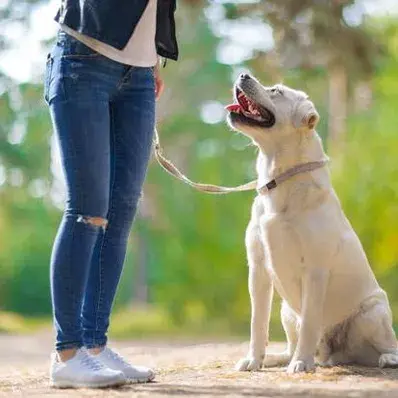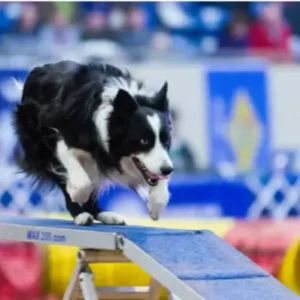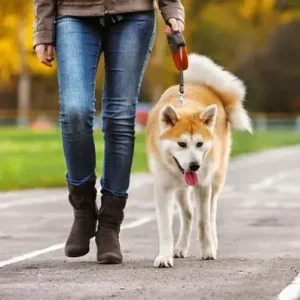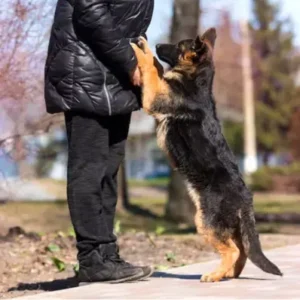Step 1: Prepare for Training
Before you begin, make sure the environment is calm and distraction-free. Pick a quiet spot where your dog can focus, and keep the training sessions short—around 5 to 10 minutes—so your dog doesn’t get overwhelmed. You’ll need a few things:
- Small, tasty treats your dog loves.
- A leash, if necessary.
- Patience, consistency, and a positive attitude.
Training should be fun and rewarding for both you and your dog.
Step 2: Get Your Dog's Attention
To start, grab your dog’s attention by calling their name or making a sound that catches their focus. Hold a treat close to their nose. This will direct their attention to you and the treat, helping them stay focused on the task.
Step 3: Lure the Dog into the Sitting Position
Hold the treat in front of your dog’s nose and slowly move your hand upward and toward their tail. This motion should naturally cause your dog to lower their hind end into a sitting position. As soon as their bottom touches the floor, say the command “sit” in a calm and firm voice. Immediately give them the treat.
- Tip: Move the treat slowly and deliberately to avoid confusing your dog or making them jump.
Step 4: Use the Command
Once your dog sits, repeat the word “sit” as you reward them with the treat. The goal is to associate the command with the action. Always use the same word and tone, so your dog learns what “sit” means. This consistency will help them understand what’s expected.
Step 5: Reward and Praise
When your dog successfully sits, immediately praise them enthusiastically and give them a treat. Positive reinforcement will make your dog eager to repeat the behavior. The more excited you are, the more your dog will want to engage in the training.
- Tip: Your praise should be upbeat and cheerful, reinforcing the idea that sitting is a great thing to do.
Step 6: Repeat and Practice
Repetition is key to success. Practice the “sit” command several times in each session, but keep it short to maintain your dog’s interest. Aim for multiple short sessions throughout the day rather than one long session. Over time, you can reduce the number of treats, replacing them with verbal praise or affection as your dog starts reliably sitting on command.
- Tip: Always end training sessions on a positive note, even if it takes a little extra time for your dog to get it right.
Step 7: Add Distractions
Once your dog has mastered sitting in a quiet, distraction-free environment, start adding mild distractions. Practice in different settings like your backyard, a park, or with other people and dogs around. This will help your dog learn to sit on command, no matter the situation.
How to Train a Dog to Sit Pretty
To train your dog to sit pretty, start by ensuring they know the basic “sit” on command. In a quiet space, hold a treat above their head and move it backward, encouraging them to lift their front paws and balance on their hind legs.
Once they begin to lift their paws, say “sit pretty” or “beg” consistently. Reward them immediately with praise and a treat when they hold the position. Keep training sessions short, fun, and regular, gradually increasing the duration as they master the trick. With patience, your dog will soon learn to sit pretty!
Make Sitting the Default Behavior
To ensure your dog learns to sit reliably, it’s helpful to make sitting their default behavior. This means that instead of simply waiting for you to ask them to sit, your dog will naturally choose to sit when unsure of what to do.
By consistently rewarding your dog for sitting on their own, they’ll start to associate sitting with positive outcomes, making it their go-to response in various situations.
Common Mistakes to Avoid
To ensure effective training, avoid these common mistakes:
- Inconsistency: Always use the same word and gesture for “sit.” Changing commands can confuse your dog.
- Overloading with treats: Gradually reduce the frequency of treats and rely more on praise as your dog becomes proficient.
- Being impatient: Training takes time. Be patient and stay positive, even if your dog doesn’t pick up the command right away.
Training your dog to sit is a simple but essential command that lays the foundation for more advanced training. With consistency, patience, and positivity, you’ll teach your dog to sit in no time.
Along with this, learning how to house-train a dog is crucial for good behavior. With regular practice, your dog will become an expert at sitting, making your life as a pet owner easier and more enjoyable.








